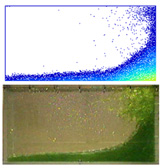

|
In rough seas, it has been commonly occurring that upper structures of a ship are destructed by severe impact of green water and the ship hull is damaged by severe slamming on the bottom or flare at the fore part of a ship. To avoid these sea disaster, rapid progress in the research on strongly nonlinear wave-body interactions has been desired. The research so far on this topic has been based mainly on experiments, and the development in the numerical analysis was rather slow due to complexity of the phenomena and difficulty in the numerical treatment. However, recent prominent development in CFD (Computational Fluid Dynamics) methods, especially multi-phase computations using interface capturing schemes, enables us to study the problems that have been intractable.
It seems that there are two major approaches in this regard. The first is based on the finite-difference method using Cartesian grids, typical one of which is the CIP-based Cartesian grid method. This method was developed at RIAM, Kyushu University and has been validated especially for 2-D problems through comparison with experiments. At present, strongly nonlinear 3-D problems including wave breaking, violent splash and air entrainment can be computed with this method as shown below (althogh there is still quantitative difference when compared with measured results such as the detail in the pressure on the deck). |

|
The other approach is based on the particle methods, typically MPS (Moving Particle Semi-implicit) method, in which the fluid motions are modelled with uniformly-distributed particles and computations can be made in a Lagrangian manner. Therefore, unlike grid-using methods, no numerical diffusion exists practically at the expense of large computation time.
The MPS method is powerful especially for the interior problems such as the tank sloshing. Shown on the right is an example of computed results for the free-surface profile inside a rectangular tank which is forcedly oscillated in sway at a period near the resonance of tank sloshing. We can see good agreement, including the splash and fragmentation of fluid.
As described above, it is true that the numerical analysis methods for strongly nonlinear flows are rapidly developing. However, emphasis has been placed on the hydrodynamic analysis and floating bodies are mostly treated as rigid. What is needed actually is precise prediction of nonlinear wave loads and resulting structure responses due to severe impact by the green water and slamming. To realize this requirement, a new analysis method must be studied and developed for treating strongly nonlinear fluid-structure interaction problems. A promising method would be obtained by combining the frontier-end techniques in CFD for the hydrodynamic part and in FEM for the structural part. It seems that we still have a long way to go.
|

|
 Link to
Useful Sites regarding CFD CODES Link to
Useful Sites regarding CFD CODES Home Page of Professor Kashiwagi
Home Page of Professor Kashiwagi
|
